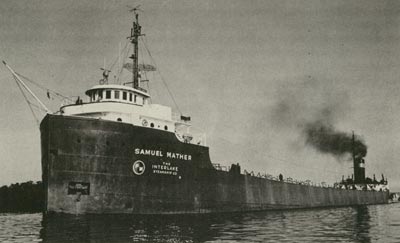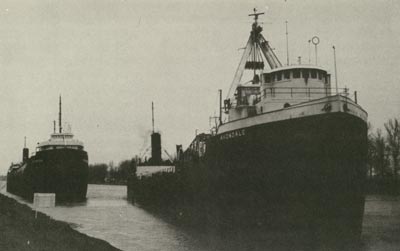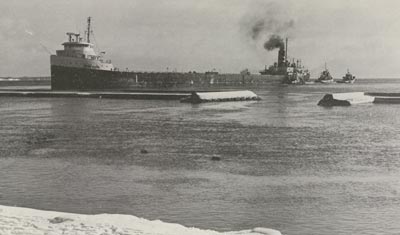Table of Contents
| Title Page | |
| Meetings | |
| The Editor's Notebook | |
| Marine News | |
| Lay-up Listings | |
| A Famous Trio comes to the Lakes | |
| Additional Marine News | |
| Table of Illustrations |
In our December issue we mentioned that the Interlake Steamship Company's bulk carrier SAMUEL MATHER (V) had been sold to the Soo River Company (Robert Pierson Holdings Ltd.) and would operate in 1976 under the name JOAN M. McCULLOUGH. The MATHER was due to leave Ashtabula December 18 in tow of the G-tug OHIO but she did not get away until the following day, arriving at Port Colborne on December 20th. She has been laid up along the West Street wharf and will spend the winter there, during which time she will be converted to burn oil fuel. It appears that she will receive the oil burners from the now-retired Reoch self-unloader AVONDALE (II). Last month we also mentioned the possibility that two other vessels would also make the change to the Soo River Company but at that time we could not reveal any further information. However, we can now confirm that the second Pierson purchase is THOMAS E. MILLSOP, formerly a unit of the fleet of the National Steel Corporation. The MILLSOP, second vessel of that name to sail the lakes, is a 589-footer built in 1925 by the Great Lakes Engineering Works at River Rouge, Michigan. Built for the Wilson Transit Company as (a) WILLIAM C. ATWATER, she later served Wilson as (b) E. J. KULAS (II) and (c) BEN MOREELL (I). She joined the Hanna fleet in 1955 at which time she was given her present name. The MILLSOP arrived at Port Colborne under her own power on December 18th and will winter alongside the West Street wharf. When she enters service for her new owners in 1976 it will be with the name (e) E. J. NEWBERRY.

SAMUEL MATHER (V) will sail in 1976 as JOAN M. McCULLOUGH for the Soo River Company. Photo by J. H. Bascom August 15, 1973, in Little Rapids Cut.
It gives us a bit of a laugh to announce the details of the third acquisition. Back last summer when we forecast the sale of A. T. LAWSON to the Soo River Company we were greeted with general disbelief. But despite the delay in the completion of the deal, the sale was closed on the morning of December 17th. That night the LAWSON cleared Buffalo for Toledo where she loaded a cargo of soya beans. She arrived at Hamilton on December 21 and will winter there with her storage cargo. We believe that she will be renamed (d) GEORGE G. HENDERSON in honour of the marine superintendent of Westdale Shipping Ltd. The LAWSON is 580.8 feet in length and was built in 1909 by the Great Lakes Engineering Works at Ecorse for the Shenango Furnace Company as (a) SHENANGO (I). She was sold in 1958 to the American Steamship Company, Buffalo, and was renamed (b) B. W. DRUCKENMILLER. She took on her present name in 1964 at which time she was sold to the Wilson Marine Transit Company. She passed to Kinsman in 1972 and to S & E Shipping Corp. in 1974.
Meanwhile, the sale of SAMUEL MATHER (V) leaves the Interlake Steamship Company without a ship named in honour of Mather, one of the founders of Pickands Mather and Company. This situation will be remedied in 1976 when the steamer FRANK ARMSTRONG will become (c) SAMUEL MATHER (VI). The ARMSTRONG will spend the winter at Buffalo with storage grain for the Pillsbury mill. She was built in 1943 by the Great Lakes Engineering Works at Ashtabula (Hull 522) and was the first of a series of ten L6-S-B1 bulk carriers built for the U.S. Maritime Commission by G.L.E.W. at Ashtabula and River Rouge. She entered service as (a) PILOT KNOB (I) on June 3, 1943 and ran under charter to Interlake. Her entry into service was hardly auspicious as on her maiden voyage she collided with the C.S.L. bulker GODERICH in the St. Mary's River and severely damaged her bow. The ARMSTRONG became the property of Interlake in 1944 when she was exchanged for several overage vessels from the fleet. She has operated for Interlake ever since.
The Bethlehem Steel Corporation's steamer ARTHUR B. HOMER (near sister to the lost EDMUND FITZGERALD) re-entered service in Mid-December after undergoing lengthening at Fraser Shipyards, Superior, Wisconsin. A new midbody 96 feet in length was inserted aft of hatch number eleven and the addition has given the vessel an overall length of 826 feet.
Observers can hardly have missed noticing the number of vessels that have been lengthened at lake shipyards over the past few years. The latest in the series of such operations is the U.S. Steel self-unloader JOHN G. MUNSON which is getting the treatment at Superior this winter. Although several other lengthenings have been rumoured, the next to be announced is to involve the Cleveland-Cliffs Steamship Company's bulk carrier WALTER A. STERLING which will go to the Lorain yard of the American Shipbuilding Company in May 1976 for the insertion of a 96-foot midbody. At present the STERLING measures 716.5 feet in length (730 overall). She was originally a tanker built by Bethlehem at Sparrows Point in 1942 and she spent her early years as CHIWAWA, although it appears (depending upon which source you read) that she started life as either MOBILOIL or SAMOSET. She was lengthened and converted to a straight-deck lake bulk carrier in 1961.
The fleet of canal motorships operated by N.M. Paterson and Sons Ltd., Thunder Bay, has been much depleted recently. LACHINEDOC and CALGADOC were both sold earlier in 1975 and this left TROISDOC as the only operating unit. Then SARNIADOC was fitted out to carry corn from Wallaceburg to Cardinal and she operated through the autumn even though she is not in the best of condition. We now hear that she too will be leaving the lakes, probably in April 1976, and we presume that she has been sold to off-lakes owners already even though we do not know who these owners may be. We have heard nothing about a sale for TROISDOC and it is to be hoped that she will be retained, for if the company disposes of her it will not be able to run to Wallaceburg at all unless the federal government chips in with funds to dredge the Snye River, an operation which would be required to get even the diminutive MONDOC or LAWRENDOC upstream.
Now that ENGLISH RIVER has established herself on the run between Bath and Toronto carrying cement for Canada Cement Lafarge, the rumours are flying to the effect that C.S.L. may convert the sistership FRENCH RIVER to a bulk cement carrier. FRENCH RIVER has lain idle at Hamilton for several years with the exception of a very short period during the summer of 1975 when she came out to make one round trip up the lakes. If she should be converted, it would be to replace one of two vessels, either METIS or CEMENTKARRIER, and it doesn't take too much imagination to figure out which one it would likely be. Nothing by way of a formal announcement has yet been made so we shall have to be patient and await developments.
Names have been announced for the two tankers being built for Gulf Oil Canada Ltd. by Marine Industries Ltd. at Sorel, Quebec. Hulls 434 and 435, respectively, will be christened GULF GATINEAU and GULF MACKENZIE.
Last issue we commented upon the retirement of the Reoch self-unloader AVONDALE. Unfortunately, a small error seems to have crept into our account in that we stated that, after having been stripped in Port Colborne harbour, the vessel was moved down to a lay-up berth on the Old Canal on November 29. Of course, it was actually on Sunday, November 30 that this last journey was taken by the old steamer. And Ye Ed should know - he stood for several hours in the pouring rain and blustering winds watching her make her way down to her final resting place!

The weather was terrible for photography, but the Editor's camera caught AVONDALE backing past PETER ROBERTSON into the Old Canal at Humberstone, November 30, 1975, on her final voyage.
We earlier reported on the possibility that the veteran Kinsman steamer HARRY L. ALLEN would be given her inspection and survey this fall, thus prolonging her active life. It is with pleasure that we can advise that the ship was on the dock at Superior in early December and apparently passed inspection with flying colours. It seems that her owners felt it was cheaper for them to dock the ALLEN than to put in hand the repairs necessary to reactivate CHICAGO TRADER, despite the fact that this latter vessel is still in class.
Prior to Christmas, Upper Lakes Shipping's stemwinder WHEAT KING went to Port Weller and is now ensconced in the drydock where she will be lengthened over the winter months. The job will also include the fitting of a bowthruster and a controllable pitch propellor.
Meanwhile, Port Weller Dry Docks Ltd. has won a $39 million contract to build an ice-breaking bulk carrier specially designed for service to the arctic regions. The vessel, not surprisingly to be christened ARCTIC, will be owned by a new firm in which the Canadian federal government will hold a 51% interest. The remaining shares of the company (as yet unidentified by name) will be held by Federal Commerce and Navigation Ltd., Canada Steamship Lines Ltd., and Leitch Transports Ltd. No details of the dimensions of the vessel have yet been announced. The yard hopes that work on the ship will begin next summer once the new Upper Lakes Shipping self-unloader is off the graving dock shelf.
As time passes, more and more details come to light concerning the loss of the Columbia steamer EDMUND FITZGERALD on Lake Superior on November 10, 1975. The vessel cleared Silver Bay, Minnesota, at 1:30 p.m. on Sunday, November 9th with a cargo of 26,216 tons of taconite pellets for delivery to the Ecorse plant of the Great Lakes Steel Company. On her trip down Lake Superior, during which she encountered the storm that was to prove her undoing, she was accompanied by the U.S. Steel bulk carrier ARTHUR M. ANDERSON under the command of Capt. J. Cooper. The two ships fought their way down the storm-tossed lake through Sunday night and on Monday it appears that both skippers decided to take their vessels to shelter behind Caribou Island, a small rocky island located about 25 miles south of the much larger Michipicoten Island. The two ships stayed in the shelter of Caribou during the mid-day hours of Monday and then a decision was made to continue down the lake in the hope of reaching the full shelter of Whitefish Bay. Caribou is surrounded by shoal water with varying depths over a rocky bottom and with the large seas running on the lake, there would have been a great fluctuation from moment to moment in the depth of available water at any given spot. In the heavy seas, could the FITZGERALD have struck the shoal, doing damage to her hull through which water may have entered? From Caribou Island it was a trip of about forty miles to the spot where the FITZGERALD foundered off Coppermine Point, a location described precisely as 47 degrees, 9 minutes, 4 seconds North; 85 degrees, 16 minutes West.
At the time of the accident the press was making much of a statement allegedly made by Capt. McSorley of the FITZGERALD just prior to the sinking, a statement concerning the vessel making water as a result of some unspecified damage. It was touted in the papers that the ship's hatches must have become uncovered, but to those who know the size and weight of single-piece steel hatch covers and the way they are dogged down to the coamings, this sort of speculation seems ludicrous. The spot on the lake at which the disaster occurred is just about where a downbound vessel would alter course to a more southerly heading to take her into Whitefish Bay. Such a manoeuvre in a wind of the direction and velocity that was blowing on the evening of November 10 would put a vessel almost broadside to the heavy seas and right in the trough of the waves, a most uncomfortable position at the best of times. Whether the ship had damaged herself at Caribou or not, this would have been the moment at which the greatest strain would have been placed on the vessel's fabric. It is not beyond the realm of possibility that at this point she simply cracked and broke apart. The cargo hold was divided into three compartments, but with the ship opened up to seas of the size that were running it would not take long for the broken sections to be overwhelmed.
In the meantime, efforts are being made to obtain diving equipment suitable to permit a descent into the 525-foot depths where the ship is lying for the purpose of the positive identification of the wreck and the possible recovery of items from the ship together with the bodies of the crew, none of her men having yet come ashore. At the same time, the inquiry into the circumstances of the sinking is continuing amid allegations of everything from unseaworthiness of the ship, to the suitability of the safety equipment, to the reasons why the U.S. Coast Guard was unable to rescue any of the crew. It seems a particularly bitter result of such an unfortunate accident, but we suppose that it is to be expected.
Efforts to return the former Chicago, Duluth and Georgian Bay Transit Company passenger steamer SOUTH AMERICAN to the Great Lakes continue, but each time we hear about the vessel it seems that a new promoter is pushing the restoration project. Plans to bring the ship to Holland, Michigan, and to Mackinac Island both failed during 1975 and late in the year it was announced that a Duluth-based group was making a strong effort to take the old ship to that port for use as a hotel-restaurant-nightclub centre in a waterfront redevelopment complex. This group seems to have sounder backing than have earlier such concerns and it would appear that they have a reasonable chance of bringing the SOUTH AMERICAN back. Meanwhile the steamer herself, mouldering away in a Camden scrapyard, is in little danger of being scrapped before the project can get underway. The firm that owns the steamer, Ships Inc., is presently in the throes of bankruptcy proceedings.
Christmas Day 1975 may have been a very happy day for most of us, but we bet that the crew of the Scott Misener Steamships Ltd. bulk carrier GEORGE M. CARL wish that they had been anywhere else but aboard their ship that day. The CARL, under the command of Capt. Morey Armstrong, was en route from Toledo to Toronto with a storage cargo of soya beans consigned to Victory Mills. As the ship neared Toronto, she encountered a snowsquall and somehow lost her way. For, you see, instead of coming in to the fairway buoy at the Western Gap and making a starboard turn to come to the harbour entrance, she proceeded straight ahead and wound up in Humber Bay, a good three miles west of where she should have been. Shortly after 5:00 p.m., she came to a sudden stop when she hit shoal water and found herself hard aground, her bow about 70 feet from the offshore breakwater just west of the foot of Howard Road. To be specific, she was about half way between the Seaway Towers Hotel and the Sunnyside bathing pavilion! And all this just when most of us were sitting down to turkey dinner. The local press was not long in publicizing the plight of the freighter and Boxing Day dawned to crowds of people standing on Sunnyside Beach to watch the embarrassing situation in which the CARL found herself. The Harbour Commission tug WILLIAM REST and the Canadian Dredge and Dock tug BAGOTVILLE tried to free the steamer but all to no avail as her bow was held fast in the suction of the muddy bottom. And to make matters worse, divers had to be called to cut away a cable which fouled the CARL's propellor during the refloating efforts.

This was the scene at Toronto's Sunnyside beach on December 27, 1975 as tugs LAC COMO, WILLIAM REST, G.W. ROGERS and BAGOTVILLE tried to free the grounded GEORGE M. CARL. Photo by J. H. Bascom.
On December 27th, the same two tugs plus the McKeil tug LAC COMO from Hamilton tried again, but even with the aid of G. W. ROGERS which was summoned from Kingston, no success was achieved, despite the fact that the stern of the CARL was free to swing. In the afternoon the tug ARGUE MARTIN from Hamilton arrived with a deck barge on which it was planned to drop the CARL's anchors. One more pull was made in the hope that it would work and with the assistance of the MARTIN it did. The CARL came free at 4:17 p.m., almost exactly 48 hours after her grounding, and she then proceeded to a layup berth in the Ship Channel. Understandably, an inquiry will be held to determine how it might be possible for the ship to be so far off course despite the various aids to navigation and the fact that the shore should have been visible to those on watch since the ship was so close to the beach.
Previous Next
Return to Home Port or Toronto Marine Historical Society's Scanner
Reproduced for the Web with the permission of the Toronto Marine Historical Society.